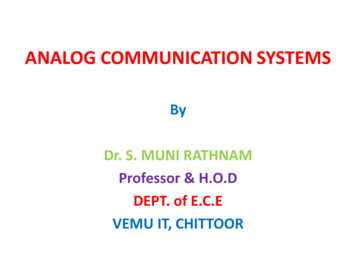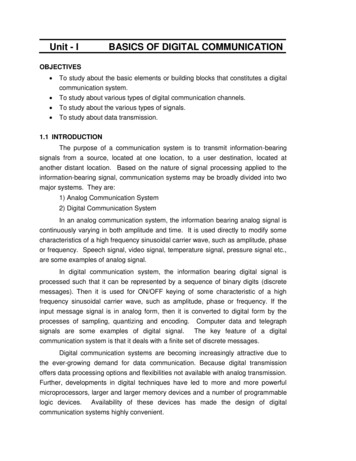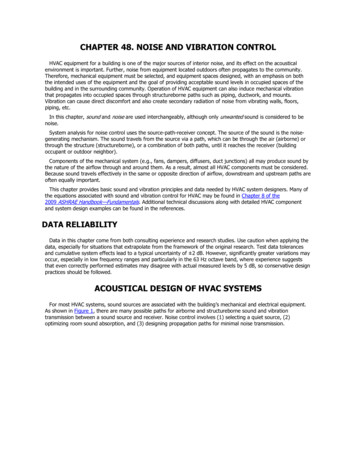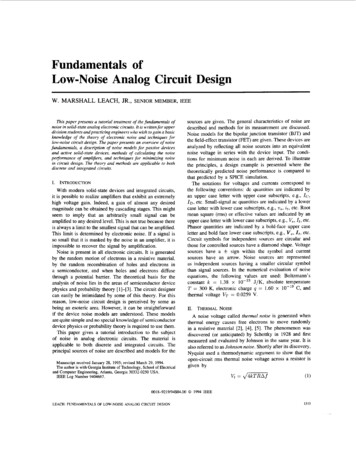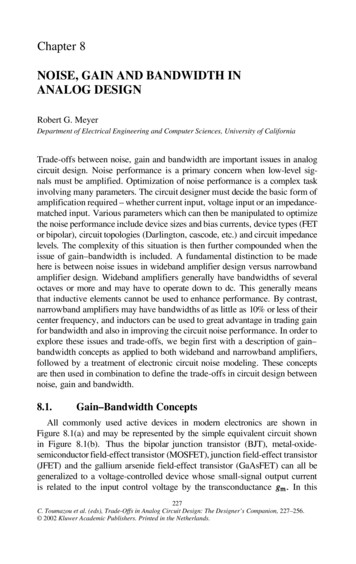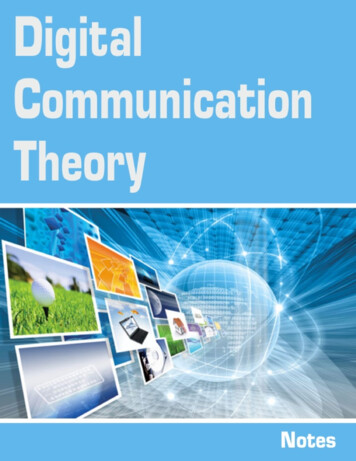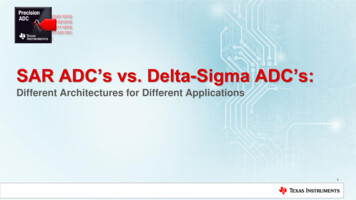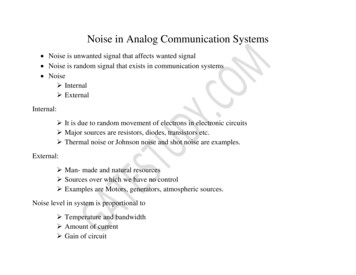
Transcription
Noise in Analog Communication Systems Noise is unwanted signal that affects wanted signal Noise is random signal that exists in communication systems Noise Internal ExternalInternal: It is due to random movement of electrons in electronic circuits Major sources are resistors, diodes, transistors etc. Thermal noise or Johnson noise and shot noise are examples.External: Man- made and natural resources Sources over which we have no control Examples are Motors, generators, atmospheric sources.Noise level in system is proportional to Temperature and bandwidth Amount of current Gain of circuit
Resistance of circuitEffect of noise Degrades system performance (Analog and digital) Receiver cannot distinguish signal from noise Efficiency of communication system reducesTypes of noise Thermal noise/white noise/Johnson noise or fluctuation noiseShot noiseNoise temperatureQuantization noiseThermal Noise: This noise is generated due to thermal motion (Brownian motion) of electronsinside resistor. This noise is zero at absolute zero degree Kelvin and generated when temperaturerises, also called thermal noise. Also called Johnson noise who invented it.Thermal noise also referred as ‘White noise’ since it has uniform spectral density across the EMSpectrum.
PSD of thermal noise 𝑆𝑛 (𝑓) is𝑆𝑛 (𝑓) 𝑘𝑇2( where k is Boltzman’s constant and T is temperature)kT is denoted by N0Then𝑆𝑛 (𝑓) 𝑁02
Work of Johnson and Nyquist gave the expression for noise power𝑃𝑛 𝑣̅𝑛2 4𝑘𝑇𝐵𝑅 𝑣𝑜𝑙𝑡 2Where,k Boltzman constantT Absolute temp. (Kelvin)B Bandwidth (Hz)R Resistance (ohms)Where 𝑣̅𝑛 is mean noise voltage.SHOT NOISEIt is electronic noise that occurs when there are finite number of particles that carry energy such aselectrons or photons.Due to analogy of lead shots called shot noise.It has uniform spectral density like thermal noise.Determination of Noise levelSignal to noise level ratio (SNR)
𝑆 𝑃𝑜𝑤𝑒𝑟 𝑜𝑓 𝑢𝑠𝑒𝑓𝑢𝑙 𝑠𝑖𝑔𝑛𝑎𝑙 𝑣𝑜𝑙𝑡𝑎𝑔𝑒 𝑁𝑃𝑜𝑤𝑒𝑟 𝑜𝑓 𝑛𝑜𝑖𝑠𝑒 𝑣𝑜𝑙𝑡𝑎𝑔𝑒𝑆𝑖 𝑁𝑆𝑖𝑔𝑛𝑎𝑙 𝑡𝑜 𝑛𝑜𝑖𝑠𝑒 𝑟𝑎𝑡𝑖𝑜 𝑎𝑡 𝑖𝑛𝑝𝑢𝑡𝑖𝑁𝑜𝑖𝑠𝑒 𝐹𝑖𝑔𝑢𝑟𝑒 𝑆𝑖𝑔𝑛𝑎𝑙 𝑡𝑜 𝑛𝑜𝑖𝑠𝑒 𝑟𝑎𝑡𝑖𝑜 𝑎𝑡 𝑜𝑢𝑡𝑝𝑢𝑡 𝑆0 𝑁0Noise figure is always 1Noise temperatureEquivalent noise temperature is not the physical temperature of amplifier, but a theoretical construct,that is an equivalent temperature that produces that amount of noise power𝑇𝑒 𝑇(𝐹 1)Noise figure of cascaded stagesFRIIS formula for calculating total noise factor of several cascaded amplifiers𝐹 𝐹1 𝐹2 1 𝐹3 1 𝐺1𝐺1 𝐺2𝐹1 , 𝐹2 , & 𝐺1 , 𝐺2 ,𝑒𝑡𝑐 𝑎𝑟𝑒 Noise figure and gains of different stages in cascade.Note that noise figure is mainly dominated by first two stages.
Effect of Noise on AM Systems:The channel introduces additive noise in message and thus message received becomes corrupted.Figure of merit is defined𝑆0 𝑁0𝛾 𝑆𝑖 𝑁𝑖Modulation system with higher γ has better noise performance.Total noise Noise power spectral density Bandwidth𝑁0𝑁 𝑊2Noise amplitude is having Gaussian distribution i.e. additive white Gaussian Noise (AWGN)For AM-SC For both DSB and SSB γ 1Thus S/N ratios at input and output of detector are identical i.e. no improvement is S/N ratioFor conventional AM using envelope detector𝛾 1 3 𝑓𝑜𝑟 𝜇 1The maximum values of γ is 1/3 for modulation index of unity
Noise in Angle Modulated SystemsLike AM, noise performance of angle modulated systems is characterized by parameter γ𝛾𝐹𝑀 3 2𝛽2If it is compared with AM𝛾𝐹𝑀 1 𝜔𝐹𝑀 2 ()𝛾𝐴𝑀 2 𝜔𝐴𝑀Note if bandwidth ratio is increased by a factor 2, then𝛾𝐹𝑀 𝛾𝐴𝑀 increases by a factor 4This exchange of bandwidth and noise performance is an important feature of FM.FM Threshold Effect In FM Systems, where signal level is well above noise ratio and demodulated signal to signalnoise ratio are related by𝑆 3. 𝛽 2 . 𝐶 𝑁𝑁S/N – Signal to noise ratio at output of demodulatorβ – Modulation index
C/N – Carrier to noise ratio at input of demodulator Does not apply when S/N decreases below certain point called ThresholdFM system is more susceptible to noise threshold as compared to AM.Threshold improvement can be obtained by Pre-emphasis and De-emphasis
Pre-emphasis: Improving signal to noise ratio by increasing the magnitude of high frequencysignal with respect to lower frequency signals. A simple high pass filter can serve as transmitter’s pre-emphasis circuit De-emphasis: Improving signal to noise ratio by decreasing the magnitude of high frequencysignals with respect to lower frequency signals A simple low pass filter can operate as de-emphasis circuit in receiver.The combined effect of these circuit is to increase signal to noise ratio for high frequencycomponents during transmission, so that they are not masked by noise
Noise in Analog Communication Systems Noise is unwanted signal that affects wanted signal Noise is random signal that exists in communication systems Noise Internal External Internal: It is due to ra

